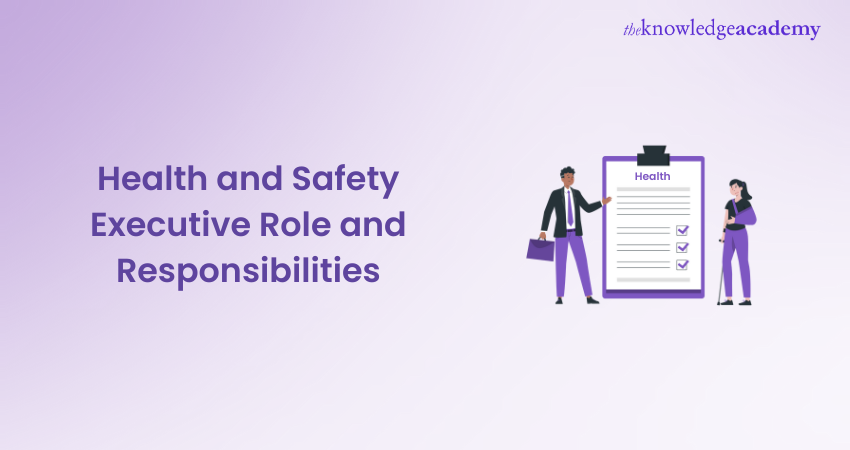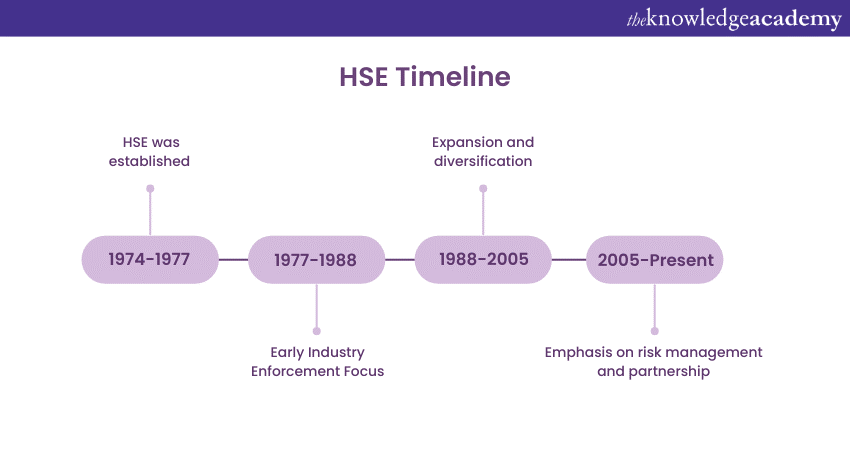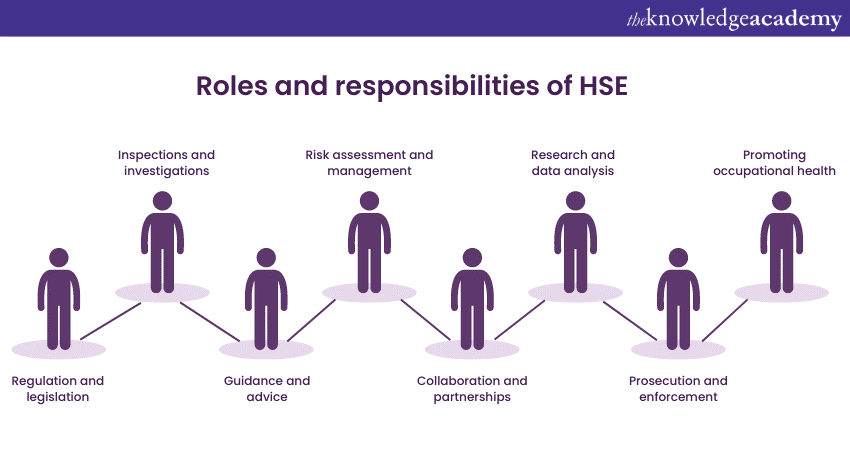We may not have the course you’re looking for. If you enquire or give us a call on 01344203999 and speak to our training experts, we may still be able to help with your training requirements.
Training Outcomes Within Your Budget!
We ensure quality, budget-alignment, and timely delivery by our expert instructors.

Are you wondering What is the Role of the Health and Safety Executive? The Health and Safety Executive Role effectively safeguards employees and prevents accidents. The HSE's mission is to prevent work-related death, injury, and ill-health by regulating and enforcing health and safety laws, providing guidance, and raising awareness.
Employers rely on skilled health and safety executives to implement important safety policies and systems. Understanding the responsibilities and required skills is key if you're choosing a career in this field. This blog will help you explore the significant contributions of the HSE in ensuring workplace safety and protecting workers' well-being. Continue reading for valuable insights!
Table of Contents
1) What is HSE?
2) Health and Safety Executive Role and Responsibilities (HSE)
3) Skills required for Health and Safety Executive Role (HSE)
4) Conclusion
What is HSE?
The HSE is a government agency in the UK that oversees workplace health and safety regulations. The Health and Safety Executive (HSE) was created under the Health and Safety at Work Act 1974 to promote workplace safety and protect workers' well-being. It helps in developing and proposing regulations related to workplace safety, which are then reviewed and approved by the government.

The HSE has the authority to create both primary and secondary legislation. Primary legislation includes important Acts like the Health and Safety at Work Act 1974, which forms the foundation of UK workplace health and safety regulations. Secondary legislation governed by the HSE includes specific regulations, guidelines, and codes of practice for workplace health and safety. These laws aim to ensure workers' well-being and prevent workplace accidents and injuries.

Health and Safety Executive Role and Responsibilities (HSE)
HSE’s enforce health and safety regulations in shops, offices, and other service sector establishments. Compliance with these regulations is essential for employers to prioritise the safety of their workers. The HSE conducts on-the-spot inspections and record checks to ensure full compliance.
Health and Safety Executive Role
The Health and Safety Executive (HSE) holds a crucial role in safeguarding the well-being of employees and the public within workplaces. The significant roles of an HSE are as follows:
1) Assessing work processes
The HSE evaluates current work procedures and practices to identify potential hazards, risks, or areas for improvement. This examination ensures that workplace processes are safe and comply with health and safety regulations. Health and Safety Executives carefully examine a company's operations to understand its rules and regulations. This helps them identify the essential areas for improvement and ensure consistent implementation. By making necessary changes early on, they ensure the safety of employees in the workplace.
2) Developing safety policies
The HSE creates rules and guidelines that promote a safe work environment. These policies outline what employees and employers should do to protect themselves and comply with Health and Safety regulations. HSE personnel are responsible for developing effective health and safety policies that outline guidelines, procedures, and standards to be followed in the workplace. These policies ensure a systematic approach to managing risks and protecting employee well-being.
3) Researching equipment and innovations
The health and safety industry is continuously evolving. This happens because new research suggests policy changes or new equipment can better protect employees. Health and safety executives stay updated on the latest equipment and industry advancements. By understanding their field and employees' risks, they can create effective safety policies to keep them safe at work. The HSE stays updated on the latest tools and technologies related to workplace safety. They research and evaluate new equipment to ensure its safety and advise on proper usage to minimise risks.
4) Reviewing injury reports
HSE professionals review reports of workplace injuries and incidents. By analyzing these reports, they gain insights into the causes and patterns of accidents, allowing them to take preventive measures to reduce similar incidents occurring in the future.
5) Compiling safety reports
Once health and safety executives develop and implement new policies, they write reports to assess the impact of these changes. These reports evaluate how the policies have affected workplace injuries and the associated costs. It is necessary as it allows them to share the outcomes of their work with senior staff.
By conveying the risks and benefits of the new policies through these reports, health and safety executives can encourage management to take necessary actions to address safety concerns. This support from the organisation makes it easier to enforce the new rules and regulations, ultimately ensuring the well-being of everyone in the workplace.
Attain knowledge about the best practices to investigate incidents efficiently. Join our NEBOSH HSE Introduction To Incident Investigation Training today to learn more!
Health and Safety Excutive Responsibilities
The key responsibilities of a HSE include:
a) They work towards creating a safety culture and minimising workplace risks. They aim to prevent accidents, injuries, and illnesses through effective health and safety measures.
b) They stay updated with the latest industry standards and research to identify improved ways of ensuring health and safety regulations compliance. This helps them implement best practices and recommend suitable measures to protect employees.
c) They formulate comprehensive policies, strategies, and procedures that outline the guidelines and standards for maintaining a safe working environment.
d) They enforce compliance with health and safety laws by conducting investigations, inspections, and, if necessary, initiating legal prosecutions against non-compliant businesses.
e) They offer expert advice, guidance, and relevant information on health and safety practices to employers, employees, and other stakeholders.
f) They oversee licensing activities in industries involving significant hazards, ensuring proper safety measures are in place to protect workers and the surrounding environment.
g) They actively engage with workplaces to raise awareness of health and safety through various means, such as training sessions, campaigns, and educational initiatives.

Skills required for the Health and Safety Role (HSE)
Here are key skills that contribute to the success of a Health and Safety Executive:
a) Attention to detail: Health and safety executives pay close attention to small details, carefully examining work processes, equipment, and safety procedures. Their keen observation skills help them identify potential risks or hazards that may be overlooked.
b) Problem-solving: Health and safety executives are skilled problem solvers. They analyse complex situations, investigate accidents or incidents, and find effective solutions to prevent future occurrences. Their ability to assess risks and devise strategies ensures a safer work environment.
c) Communication: Effective communication is essential for health and safety executives. They must clearly communicate safety policies, procedures, and regulations to employees at all levels. They ensure that everyone is able to understand their roles and responsibilities in maintaining workplace safety through collaboration, training sessions, and discussions.
d) Hazard identification: Health and safety executives possess expertise in identifying workplace hazards. They conduct thorough risk assessments, inspect facilities, and analyse data to identify potential dangers proactively. Their knowledge enables them to implement preventive measures and recommend safety improvements.
Learn the key internal and external health and safety information sources with our NEBOSH Award In Health And Safety At Work Course. Join the course now!
Conclusion
We hope this blog helps you understand the role of the Health and Safety Executive. Choosing your career as a Health and Safety Executive provides you with opportunities for continuous learning. It helps you in staying up-to-date with the latest industry advancements. As a Health and Safety Executive, you enjoy working in diverse industries and collaborating with various stakeholders while playing a pivotal role in promoting a workplace safety culture.
Learn how to implement the health and safety best-practice guidance with our NEBOSH Courses. Sign up today!
Frequently Asked Questions
Upcoming Health & Safety Resources Batches & Dates
Date
 IOSH Managing Safely Course
IOSH Managing Safely Course
Mon 13th May 2024
Mon 2nd Sep 2024
Mon 18th Nov 2024







 Top Rated Course
Top Rated Course


 If you wish to make any changes to your course, please
If you wish to make any changes to your course, please


